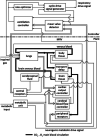Non-invasive ventilation treatment for patients with chronic obstructive pulmonary disease
- PMID: 37529410
- PMCID: PMC10388227
- DOI: 10.1049/htl2.12048
Non-invasive ventilation treatment for patients with chronic obstructive pulmonary disease
Abstract
Chronic obstructive pulmonary disease (COPD) affects the lives of millions of patients worldwide. Patients with advanced COPD may require non-invasive ventilation (NIV) to support the resultant deficiencies of the respiratory system. The purpose of this study was to evaluate the effects of varying the continuous positive airway pressure (CPAP) and oxygen supplementation components of NIV on simulated COPD patients by using an established and detailed model of the human respiratory system. The model used in the study simulates features of advanced COPD including the effects on the changes in ventilation control, increases in respiratory dead space and airway resistance, and the acid-base shifts in the blood seen in these patients over time. The results of the study have been compared with and found to be in general agreement with available clinical data. Our results demonstrate that under non-emergency conditions, low levels of oxygen supplementation combined with low levels of CPAP therapy seem to improve hypoxemia and hypercapnia in the model, whereas prolonged high-level CPAP and moderate-to-high levels of oxygen supplementation do not. The authors conclude that such modelling may be useful to help guide beneficial interventions for COPD patients using NIV.
Keywords: decision support systems; lung; medical expert systems; oxygen; patient treatment; physiological models; ventilation.
© 2023 The Authors. Healthcare Technology Letters published by John Wiley & Sons Ltd on behalf of The Institution of Engineering and Technology.
Conflict of interest statement
The authors declare no conflict of interest.
Figures







Similar articles
-
Home Non-Invasive Ventilation for COPD: How, Who and When?Arch Bronconeumol (Engl Ed). 2018 Mar;54(3):149-154. doi: 10.1016/j.arbres.2017.12.005. Epub 2018 Jan 19. Arch Bronconeumol (Engl Ed). 2018. PMID: 29371025 English, Spanish.
-
ISCCM Guidelines for the Use of Non-invasive Ventilation in Acute Respiratory Failure in Adult ICUs.Indian J Crit Care Med. 2020 Jan;24(Suppl 1):S61-S81. doi: 10.5005/jp-journals-10071-G23186. Indian J Crit Care Med. 2020. PMID: 32205957 Free PMC article.
-
High-flow nasal cannula oxygen therapy versus non-invasive ventilation for chronic obstructive pulmonary disease patients after extubation: a multicenter, randomized controlled trial.Crit Care. 2020 Aug 6;24(1):489. doi: 10.1186/s13054-020-03214-9. Crit Care. 2020. PMID: 32762701 Free PMC article. Clinical Trial.
-
Management of Chronic Respiratory Failure in Chronic Obstructive Pulmonary Disease: High-Intensity and Low-Intensity Ventilation.Sleep Med Clin. 2020 Dec;15(4):497-509. doi: 10.1016/j.jsmc.2020.08.007. Sleep Med Clin. 2020. PMID: 33131660 Review.
-
Non-invasive ventilation and continuous positive pressure ventilation in emergency departments: where are we now?Emerg Med J. 2008 Apr;25(4):190-4. doi: 10.1136/emj.2007.049072. Emerg Med J. 2008. PMID: 18356344 Review.
Cited by
-
Adaptive non-invasive ventilation treatment for sleep apnea.Healthc Technol Lett. 2024 May 26;11(5):283-288. doi: 10.1049/htl2.12087. eCollection 2024 Oct. Healthc Technol Lett. 2024. PMID: 39359684 Free PMC article.
References
-
- Biselli, P. , Fricke, K. , Grote, L. , Braun, A.T. , Kirkness, J. , Smith, P. , Schwartz, A. , Schneider, H. : Reductions in dead space ventilation with nasal high flow depend on physiological dead space volume: Metabolic hood measurements during sleep in patients with COPD and controls. Eur. Respir. J. 51, 1–9 (2018). 10.1183/13993003.02251-2017 - DOI - PubMed
-
- Hayden, L.P. , Cho, M.H. , Raby, B.A. , Beaty, T.H. , Silverman, E.K. , Hersh, C.P. , the COPDGene Investigators .: Childhood asthma is associated with COPD and known asthma variants in COPDGene: A genome‐wide association study. Resp. Res. 19(209), 1–11 (2018). 10.1186/s12931-018-0890-0 - DOI - PMC - PubMed
LinkOut - more resources
Full Text Sources

